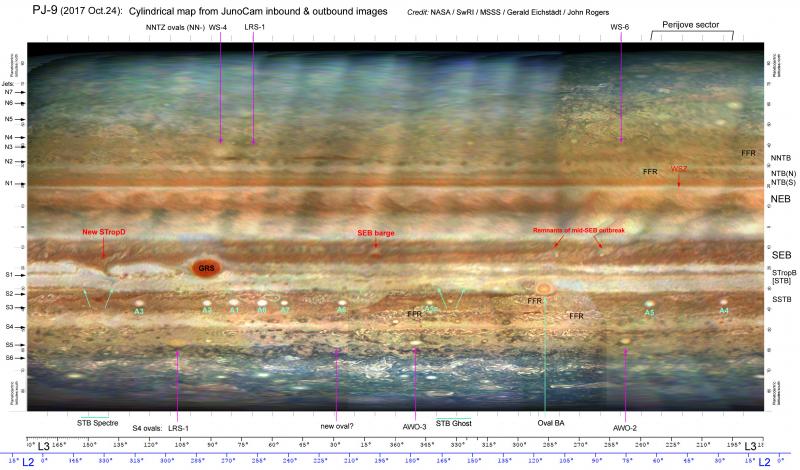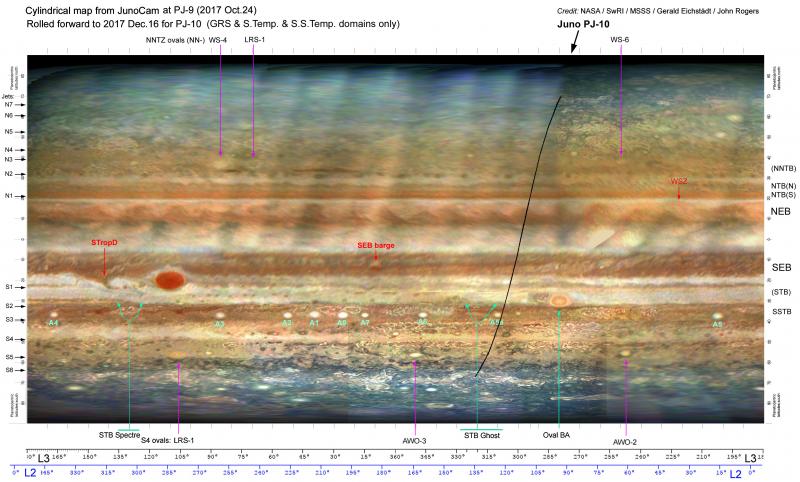Juno at Perijove-9 (Part I): Global maps
Summary: This perijove on 2017 Oct.24 took place only 2 days before Jupiter’s solar conjunction, so there were no useful ground-based observations for nearly 4 weeks up to that time. But JunoCam’s inbound and outbound images provided a good global map. This revealed an important change: a new South Tropical Disturbance had appeared, suggesting the possibility of further major changes in the South Tropical and Temperate domains in the coming year.
Figure 1 is a compilation of ground-based images in September, including the last useful ones covering the GRS and oval BA before solar conjunction; they are mostly by Clyde Foster, plus two by Isao Miyazaki. Note the prominent S.Tropical Band and shaded STropZ in this sector.
Figure 2 is a global map made from the inbound images (northern hemisphere) and outbound images (southern hemisphere), as map-projected by Gerald Eichstädt. He achieved remarkably good map projections in spite of the crescent phase of the planet, now that perijove is over the sunlit side rather than the terminator. The spacecraft orientation was different from PJ8, so the inbound images were more complete this time, but they were still restricted by the narrow crescent phase – which will only get worse at subsequent perijoves.
The map shows major changes in the southern hemisphere: most importantly and unexpectedly, a new South Tropical Disturbance (STropD), i.e. a recirculation across the S. Tropical Zone. Although it was not recognised till now, amateur images and JUPOS analysis show that it was initiated in early August when dark streaks, modestly retrograding in the northern STropZ, merged and recirculated into the mid-STropZ alongside the p. end of the STB Spectre. [We will show the data in a forthcoming report.] Early stages are visible in Fig.1. The STropD is prograding towards the GRS.
I think this enhances the likelihood of a SEB Fade developing within the coming year. In recent decades, S.Tropical Disturbances have tended to appear in association with SEB Fades (notably in 1993 and 2007*). The SEB will probably not fade immediately because the map also shows some small-scale rifting (white convective streaks) in the SEB alongside the STropD, and also at remote longitudes in the remains of the mid-SEB outbreak (also see close-ups in Part II). We will have to see how this plays out over the coming months, but I suspect that the rifts will soon die out and a SEB Fade may then develop in the first half of 2018.
There are also signs of possible disturbance in the S. Temperate domain. This domain has been in an anomalous state with no dark belt for a few years, and may be ripe for a revival of the now-absent STB, as last happened in 1993.
In the NEB, unusual large-scale wave structure – which was developing during 2017, and conspicuous in methane images — is now prominent even in visible light at all longitudes.
Figure 3 is a predictive map for perijove-10 (2017 Dec.16), made by ‘rolling forward’ the S. and S.S.Temperate domains, and the GRS, according to their recent drift rates. Juno will again fly over the p. end of the STB Ghost, as at PJ8; it’s worth imaging again because this region may undergo drastic changes next year. These images might also catch a small AWO merging with the growing SS-AWO A5a.
A slightly longer version of this report with small copies of the figures is here (PDF file): Juno-PJ9-report-I_Global_&Figs.pdf
The full-size figures are here (ZIP file): PJ9-report_JHR_Figs1-3.zip
And here are small copies of Figures 2 and 3:


| The British Astronomical Association supports amateur astronomers around the UK and the rest of the world. Find out more about the BAA or join us. |
